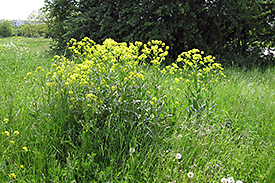Press release, 11th March 2014:
Exotic plant species alter ecosystem productivity
Researchers from the UFZ warn that ecosystems will change dramatically
Halle, Germany/ Missoula, USA/ Berkeley, USA. In their joint publication in the journal „Ecology Letters“ German and American biologists have reported an increase in biomass production in ecosystems colonised by non-native plant species. In the face of climate change, these and other changes to ecosystems are predicted to become more frequent, according to the researchers.

Invasive exotic plant species, such as the Turkish Rocket (Bunias orientalis), are often fast-growing and competitive. They may alter ecosystems by gaining dominance, increasing productivity and replacing native plant species.
The current study shows that in grassland ecosystems, native generalist herbivores such as voles – which are usually considered as a pest – may provide substantial resistance to plant invasions.
Photo: Harald Auge/UFZ
All over the world, plant and animal species are increasingly encroaching upon ecosystems where they don’t belong as a result of human influence. This phenomenon is known as a biological invasion. Observational studies on biological invasions show that the invasion of non-native plant species can alter ecosystems. One important aspect of this is biomass production: compared to intact ecosystems, the productivity of ecosystems with non-native species is considerably higher. „In such purely observational studies however, it is not possible to differentiate between cause and effect“, says Dr. Harald Auge from the Helmholtz Center for Environmental Research (UFZ). „The question is whether exotic plant species prefer to colonise more productive ecosystems, or whether increased productivity is a result of the invasion.“
To get to the bottom of this question, UFZ researchers joined forces with colleagues from the Martin-Luther University Halle-Wittenberg, the University of Montana, the University of California and the US Forest Service and staged invasions by setting up experimental sites in three disparate grassland regions –in Central Germany, Montana and California, on which 20 native plant species (from the respective region) and 20 exotic plant species were sown. Researchers investigated whether and to which extent herbivorous small mammals such as mice, voles or ground squirrels as well as mechanical disturbance to the soil would influence exotic plant species colonizing ability.
„The experimental design was exactly the same for all three regions to ensure comparability. We wanted to find out whether superordinate relationships were playing a role, irrespective of land use, species compositions and climate differences“, explains Dr Auge. When the experimental sites were not subject to any mechanical disturbance and when herbivorous small mammals had open access to the sites, then no differences could be found between the three regions in their reaction to the sowing of exotic species: biomass production was found to be only slightly higher than for ecosystems with exclusively native plant species, and susceptibility to invasions was low. „The herbivorous small mammals really surprised us“, says Dr Auge. „Their presence and appetite is largely responsible for the resistance of grasslands to exotic plant species invasions“.
If the herbivorous small mammals were excluded using fences or the soil disturbed mechanically or both, then the results were considerably different: ecosystems proved to be less resistant to invasions and biomass production turned out to be considerably higher. „It was perplexing that an increase in productivity applied to all three (from a climate perspective) completely disparate regions. Hence, there seems to be a universal phenomenon going on: exotic plant species do not necessarily prefer more productive ecosystems –their exotic provenance as such leads to an increased production of biomass, which is thus an effect and not the cause of the invasion“, Dr Auge resumes.
So far there has been no explanation as to why exotic plant species increase biomass production so dramatically. It is possible that only those non-native species that are particularly productive and competitive are able to establish successfully in a new area. Another cause could be the lack of parasites and pathogens specialised on these species. To investigate the long-term reactions of grassland ecosystems on the establishment of non-native plant species, the researchers plan future investigations on the further development of the species on the experimental sites. Dr Auge: „We assume that the non-natives will increasingly crowd out the natives from the ecosystem –a reduction in species richness would imply another dramatic change to native ecosystems.“
Publication
Maron, J.L.; Auge, H.; Pearson, D. E.; Korell, L.; Hensen, I.; Suding, K. N.; Stein, C. (2014) Staged invasions across disparate grasslands: effects of consumers, disturbance and seed provenance on productivity and species richness. Ecology Letters 17: 499-507.
http://dx.doi.org/10.1111/ele.12250
Further information
Dr. Harald Auge
Helmholtz Centre for Environmental (UFZ)
Phone: +49-(0)345-558-5309
http://www.ufz.de/index.php?de=1153
or via
Tilo Arnhold / Susanne Hufe (UFZ-Pressestelle)
Phone: 0341-235-1630
presse@ufz.de
At the Helmholtz Centre for Environmental Research (UFZ) scientists are interested in the wide-ranging causes and impacts of environmental change. They conduct research on water resources, biodiversity, the impacts of climate change and adaptation strategies, environmental and biotechnologies, bioenergy, the behaviour of chemicals in the environment and their effects on health, modelling and sociological issues. Their guiding motto: our research serves the sustainable use of natural resources and helps towards long-term food and livelihood security in the face of global change. The UFZ has over 1,100 employees working in Leipzig, Halle und Magdeburg. It is funded by the federal government, as well as by the State of Saxony and Saxony Anhalt.
The Helmholtz Association contributes to finding solutions for large and pressing issues in society, science and the economy through excellence in the following six areas of research: energy, earth and the environment, health, key technologies, structure of matter, transport and aerospace. With almost 35,000 employees and coworkers in 18 research centres and an annual budget of approx. 3.8 billion Euros the Helmholtz Association is the largest scientific organization in Germany. Work is conducted in the tradition of the renowned natural scientist Hermann von Helmholtz (1821-1894).
